
Сall us today
+30.2103230345
- Byzantine Icons
- BeesWax and Incense Icons
- Byzantine Aluminium Icons
- Byzantine Silver Plated Icons
- Framed Glass Holy Icons
- Hand Carved Icons
- Hand Made Enamel Icons
- Hand Made Icons of Christ
- Hand Made Icons of Holy Virgin Mary
- Hand Made Icons of Saints
- Hand Painted Byzantine Icons
- Hand Painted Icons Special Orders
- Icon Display Stands
- Iconostasis with Electric Lamp
- Laminated Holy Icons
- Orthodox Annual Agiologion
- Orthodox Crystal & Glass Icons
- Orthodox Pin Button Icons
- Silver Byzantine Icons
- No.1055
- No.1057 Size: 34.5 x 42cm
- No.1058 Size:31x35cm
- No.1060 Size: 26.5cm x 33cm
- No.1062 Size: 24cm x 28cm
- No.1064 Size: 21 x 26cm
- No.1065 Size: 25cm x 31cm
- No.1068 Size:22x27cm
- No.1073 Size: 23cm x 27cm
- No.1075 Size : 19cm x 24cm
- No.1078 Size: 16cm x 22cm
- No.1082 Size: 14cm x 18cm
- No.1083 Size: 13cm x 16cm
- No.M1183 Size: 14.5 x 11.5cm
- Silver Classical Collection Icons
- Wedding Crowns & Cases
- Wooden Antique Style Icons
- Wooden Byzantine Icons
- Wooden Diptychs & Triptychs
- Wooden Iconostasis
- Wooden Icons with Glass Oil Cup
- Wooden NeoClassical Icons
- Wooden Russian Style Icons
- Candle Stands
- Cemetery Funeral Products
- Church Supplies
- Andidoron Bowls
- Anointing Oil Bottles
- Baptismal Fonts
- Candelabra Ventilated
- Candle Cases & Coin Boxes
- Cement ReadyMade Church
- Chains and Gift Boxes for Englolpion Sets
- Chanter Psalter Stands
- Cherubims Exapterigo
- Church Candle Recycle Box
- Church Chairs & Throns
- Church Corridor Columns
- Church Orthodox Bells
- Church Supplies upon Request
- Crosiers – Bishop Stuff
- Ecclesiastical Alouminium Chandelier
- Ecclesiastical Candelabrum
- Ecclesiastical Censers
- Ecclesiastical Icon Stands
- Ecclesiastical Lanterns
- Ecclesiastical Special Cases
- Ecclesiastical Vase
- Ecclesiastical Vigil Oil Candles
- Ecclesiastical Zeon & Sprinkler
- Engolpion Panagia Sets
- Epitaph Kouvouklion
- Holy Apostle Cover
- Holy Communion Chalice Set
- Holy Communion Wine
- Holy Gospel Book Covers
- Holy Oil Bowls
- Holy Table Oil Candles
- Holy Table Tabernacle
- Lances – Spears for Holy Communion
- Monastic Talanton
- Orthodox Church Sconces
- Orthodox Gospel Metal Stands
- Ostrich Orthodox Decorated Egg
- Pectoral Crosses
- Reliquaries Boxes
- Tables for Church
- WoodCarved Candelabrum
- WoodCarved Chairs – Stalls
- Ecclesiastical Electric Lamps
- Ex-Voto Tamata Milagros
- Incense Burners & Orthodox Incense
- Alouminium Incense Burners
- Ceramic Incense Burners
- Holy Oil Frangrance
- Home Brass Incense Burners
- Incense Athonite
- Incense Coal
- Incense Incesco Catholic
- Incense Metal Boxes
- Incense Natural & Resins
- Incense Orthodox
- Incense Premium Athonite
- Incense Wooden boxes
- Metal Tongs for Incense
- Porcelain Incense Burners
- Orthodox CD & Book Library
- Orthodox Crosses
- Orthodox Gifts
- Gifts for the New Year
- 2024 Paschal & Church Candles
- 2026 Orthodox Calendars
- Aladdin Lamps
- Bookmarks
- Ceramic & Crystal Gifts
- Easter Coloring Dye for Eggs
- Ecclesiastical Colognes
- Gold Eye Pentants
- Holy Water Bottles
- Key Rings
- Lanterns
- Martirika
- Orthodox Car & Gifts Pendants
- Orthodox Cross Gold K14
- Orthodox Filakto
- Orthodox Icons Magnets
- Orthodox Neckwear Crosses & Icons
- Praying Ropes
- Praying Rozaries
- Prosphora Seals
- Silver 925 Car Amulets
- Silver 925 Chains
- Silver 925 Orthodox Crosses
- Silver 925 Orthodox Pendants
- Silver 925 Rings
- Silver 925 Russian Crosses
- Small Gospel Pendants
- Traditional Blue Eyes
- Various Small Icons
- Wax Healing Creams
- Wooden NeckWear Crosses
- Vestments, Traditional Costumes & Church Linens
- Baptism Clothing
- Clerics Hats
- Covers Of The Holy Grail
- Ecclesiastical Ribbons
- Epitaph Cover Koimesis
- Epitaph Covers Mourners
- Holy Communion Cup Covers
- Holy Communion Purificators & Accessories
- Iconostasis Orthodox Cover
- Orthodox Antimension
- Orthodox Belts
- Orthodox Cotton Cases and More
- Orthodox Cufflinks
- Orthodox Flags & Banners
- Orthodox Greek Flag With Holy Icons
- Rassa – Anteri
- Shroud
- Velvet Orthodox Garment & Prayers
- Vestment Embroidery Derocations
- Vestment Fabrics
- Vestments for Altar Boy
- Vigil Oil Candles
- Show more
- 2026 Orthodox Calendars
- Incense Burners & Orthodox Incense
- Incense Incesco Catholic
- Incense Athonite
- Home Brass Incense Burners
- Porcelain Incense Burners
- Incense Metal Boxes
- Metal Tongs for Incense
- Incense Orthodox
- Incense Wooden boxes
- Incense Coal
- Ceramic Incense Burners
- Alouminium Incense Burners
- Holy Oil Frangrance
- Incense Premium Athonite
- Incense Natural & Resins
- Orthodox CD & Book Library
- Orthodox Crosses
- Orthodox Gifts
- Silver 925 Chains
- Bookmarks
- Silver 925 Orthodox Crosses
- Silver 925 Orthodox Pendants
- Lanterns
- Martirika
- Wax Healing Creams
- Aladdin Lamps
- Praying Rozaries
- Gifts for the New Year
- Prosphora Seals
- Ceramic & Crystal Gifts
- Silver 925 Russian Crosses
- Various Small Icons
- Silver 925 Car Amulets
- Gold Eye Pentants
- Key Rings
- Holy Water Bottles
- Orthodox Cross Gold K14
- Wooden NeckWear Crosses
- Easter Coloring Dye for Eggs
- Ecclesiastical Colognes
- Orthodox Neckwear Crosses & Icons
- Small Gospel Pendants
- Orthodox Car & Gifts Pendants
- Traditional Blue Eyes
- Silver 925 Rings
- Orthodox Filakto
- Orthodox Icons Magnets
- Praying Ropes
- Vestments, Traditional Costumes & Church Linens
- Ecclesiastical Ribbons
- Orthodox Flags & Banners
- Orthodox Belts
- Velvet Orthodox Garment & Prayers
- Vestment Embroidery Derocations
- Covers Of The Holy Grail
- Iconostasis Orthodox Cover
- Vestments for Altar Boy
- Epitaph Cover Koimesis
- Holy Communion Purificators & Accessories
- Holy Communion Cup Covers
- Orthodox Antimension
- Baptism Clothing
- Epitaph Covers Mourners
- Orthodox Greek Flag With Holy Icons
- Orthodox Cufflinks
- Rassa - Anteri
- Orthodox Cotton Cases and More
- Vestment Fabrics
- Shroud
- Clerics Hats
- Vigil Oil Candles
- Byzantine Icons
- Hand Made Icons of Christ
- Icon Display Stands
- Orthodox Annual Agiologion
- Hand Made Icons of Saints
- Wooden Icons with Glass Oil Cup
- Hand Made Icons of Holy Virgin Mary
- Silver Classical Collection Icons
- Byzantine Silver Plated Icons
- Byzantine Aluminium Icons
- Wooden Antique Style Icons
- Hand Made Enamel Icons
- Wedding Crowns & Cases
- Wooden Russian Style Icons
- Wooden Diptychs & Triptychs
- BeesWax and Incense Icons
- Hand Painted Icons Special Orders
- Hand Carved Icons
- Laminated Holy Icons
- Wooden Byzantine Icons
- Wooden Iconostasis
- Hand Painted Byzantine Icons
- Wooden NeoClassical Icons
- Iconostasis with Electric Lamp
- Orthodox Pin Button Icons
- Silver Byzantine Icons
- No.1057 Size: 34.5 x 42cm
- No.1083 Size: 13cm x 16cm
- No.1064 Size: 21 x 26cm
- No.1073 Size: 23cm x 27cm
- No.M1183 Size: 14.5 x 11.5cm
- No.1060 Size: 26.5cm x 33cm
- No.1068 Size:22x27cm
- No.1065 Size: 25cm x 31cm
- No.1082 Size: 14cm x 18cm
- No.1055
- No.1075 Size : 19cm x 24cm
- No.1062 Size: 24cm x 28cm
- No.1078 Size: 16cm x 22cm
- No.1058 Size:31x35cm
- Orthodox Crystal & Glass Icons
- Framed Glass Holy Icons
- Candle Stands
- Cemetery Funeral Products
- 2026 Collection Paschal & Church Candles
- Church Supplies
- Ecclesiastical Alouminium Chandelier
- Candle Cases & Coin Boxes
- Candelabra Ventilated
- Ecclesiastical Special Cases
- Ecclesiastical Lanterns
- Holy Communion Wine
- WoodCarved Chairs - Stalls
- Cherubims Exapterigo
- Ecclesiastical Icon Stands
- Ecclesiastical Electric Lamps
- Church Orthodox Bells
- Cement ReadyMade Church
- Baptismal Fonts
- Epitaph Kouvouklion
- Reliquaries Boxes
- Church Chairs & Throns
- Holy Table Oil Candles
- WoodCarved Candelabrum
- Andidoron Bowls
- Tables for Church
- Ecclesiastical Vigil Oil Candles
- Ecclesiastical Censers
- Crosiers - Bishop Stuff
- Lances - Spears for Holy Communion
- Ecclesiastical Vase
- Holy Communion Chalice Set
- Orthodox Gospel Metal Stands
- Anointing Oil Bottles
- Holy Table Tabernacle
- Holy Gospel Book Covers
- Orthodox Church Sconces
- Chains and Gift Boxes for Englolpion Sets
- Monastic Talanton
- Holy Apostle Cover
- Ostrich Orthodox Decorated Egg
- Engolpion Panagia Sets
- Chanter Psalter Stands
- Ecclesiastical Zeon & Sprinkler
- Church Candle Recycle Box
- Pectoral Crosses
- Church Corridor Columns
- Ecclesiastical Candelabrum
- Holy Oil Bowls
- Church Supplies upon Request
- Ex-Voto Tamata Milagros
No products in the cart.
Return To ShopOrthodox Cotton Towel for Artoclasia With Coloured Thread
$52.99

shine bright like
star
Size : 104x104cm
The artoclasia is a service held at the end of Vespers or at the end of Orthros (Matins). Five round loaves of bread are offered by individual faithful as a sign of devotion for personal or family anniversaries such as name days and other occasions bearing close
connection with the experience of the Orthodox. The five loaves are reminiscent of the five loaves that Jesus Christ blessed in the desert and by which five thousand of His hearers were fed. The artoclasia also symbolizes and brings into practice the Agape meals of the very early Christian communities.
Then, after the faithful received the Body and Blood of Christ, they would gather in a common meal, thus signifying the brotherly association established between them by their common faith and by their receiving the same sacramental Lord. Also, the Agape meals served a charitable purpose by providing meals to the poorer from among them.
The significance behind the Orthodox artoclasia includes also the fact that, among the Orthodox, bread continues to be highly valued not only as a basic food but also as the supreme symbol of the Body of Christ;
for it is the bread which is changed by consecration in the Liturgy into the Body of Christ. Christ has been repeatedly designated as the Bread of Life, and also as “the Bread which came from heaven”. Bread does also symbolize the Church of Christ, which has spread all over ‘as the wheat on the mountains and which was gathered by Christ into one body” (Didache). Thus, bread has been given a mystical meaning according to
which it constitutes the essence of the spiritual life of the Christian.
The blessed bread of the Orthodox artoclasia has been from ancient times considered to effect personal sanctification and to help the individual against bodily infirmities and illness ‘if taken with faith’. The Greek term ‘artoclasia’ (*see the note at the bottom of the page) derives from the very words used by the Evangelists in describing the Last Supper at which Christ ‘broke bread’ and offered it to His disciples as His own Body.
Also, ‘bread is broken’ in the Orthodox artoclasia, signifying not only an identity in terms but a far more significant affinity between the Lord’s and His Church’s breaking of bread.
*from the Greek words artos/άρτος = bread and klasis/κλάσις = breaking
| Weight | 0.25 kg |
|---|
Related products
- Byzantine Icons
- BeesWax and Incense Icons
- Byzantine Aluminium Icons
- Byzantine Silver Plated Icons
- Framed Glass Holy Icons
- Hand Carved Icons
- Hand Made Enamel Icons
- Hand Made Icons of Christ
- Hand Made Icons of Holy Virgin Mary
- Hand Made Icons of Saints
- Hand Painted Byzantine Icons
- Hand Painted Icons Special Orders
- Icon Display Stands
- Iconostasis with Electric Lamp
- Laminated Holy Icons
- Orthodox Annual Agiologion
- Orthodox Crystal & Glass Icons
- Orthodox Pin Button Icons
- Silver Byzantine Icons
- No.1055
- No.1057 Size: 34.5 x 42cm
- No.1058 Size:31x35cm
- No.1060 Size: 26.5cm x 33cm
- No.1062 Size: 24cm x 28cm
- No.1064 Size: 21 x 26cm
- No.1065 Size: 25cm x 31cm
- No.1068 Size:22x27cm
- No.1073 Size: 23cm x 27cm
- No.1075 Size : 19cm x 24cm
- No.1078 Size: 16cm x 22cm
- No.1082 Size: 14cm x 18cm
- No.1083 Size: 13cm x 16cm
- No.M1183 Size: 14.5 x 11.5cm
- Silver Classical Collection Icons
- Wedding Crowns & Cases
- Wooden Antique Style Icons
- Wooden Byzantine Icons
- Wooden Diptychs & Triptychs
- Wooden Iconostasis
- Wooden Icons with Glass Oil Cup
- Wooden NeoClassical Icons
- Wooden Russian Style Icons
- Candle Stands
- Cemetery Funeral Products
- Church Supplies
- Andidoron Bowls
- Anointing Oil Bottles
- Baptismal Fonts
- Candelabra Ventilated
- Candle Cases & Coin Boxes
- Cement ReadyMade Church
- Chains and Gift Boxes for Englolpion Sets
- Chanter Psalter Stands
- Cherubims Exapterigo
- Church Candle Recycle Box
- Church Chairs & Throns
- Church Corridor Columns
- Church Orthodox Bells
- Church Supplies upon Request
- Crosiers – Bishop Stuff
- Ecclesiastical Alouminium Chandelier
- Ecclesiastical Candelabrum
- Ecclesiastical Censers
- Ecclesiastical Icon Stands
- Ecclesiastical Lanterns
- Ecclesiastical Special Cases
- Ecclesiastical Vase
- Ecclesiastical Vigil Oil Candles
- Ecclesiastical Zeon & Sprinkler
- Engolpion Panagia Sets
- Epitaph Kouvouklion
- Holy Apostle Cover
- Holy Communion Chalice Set
- Holy Communion Wine
- Holy Gospel Book Covers
- Holy Oil Bowls
- Holy Table Oil Candles
- Holy Table Tabernacle
- Lances – Spears for Holy Communion
- Monastic Talanton
- Orthodox Church Sconces
- Orthodox Gospel Metal Stands
- Ostrich Orthodox Decorated Egg
- Pectoral Crosses
- Reliquaries Boxes
- Tables for Church
- WoodCarved Candelabrum
- WoodCarved Chairs – Stalls
- Ecclesiastical Electric Lamps
- Ex-Voto Tamata Milagros
- Incense Burners & Orthodox Incense
- Alouminium Incense Burners
- Ceramic Incense Burners
- Holy Oil Frangrance
- Home Brass Incense Burners
- Incense Athonite
- Incense Coal
- Incense Incesco Catholic
- Incense Metal Boxes
- Incense Natural & Resins
- Incense Orthodox
- Incense Premium Athonite
- Incense Wooden boxes
- Metal Tongs for Incense
- Porcelain Incense Burners
- Orthodox CD & Book Library
- Orthodox Crosses
- Orthodox Gifts
- Gifts for the New Year
- 2024 Paschal & Church Candles
- 2026 Orthodox Calendars
- Aladdin Lamps
- Bookmarks
- Ceramic & Crystal Gifts
- Easter Coloring Dye for Eggs
- Ecclesiastical Colognes
- Gold Eye Pentants
- Holy Water Bottles
- Key Rings
- Lanterns
- Martirika
- Orthodox Car & Gifts Pendants
- Orthodox Cross Gold K14
- Orthodox Filakto
- Orthodox Icons Magnets
- Orthodox Neckwear Crosses & Icons
- Praying Ropes
- Praying Rozaries
- Prosphora Seals
- Silver 925 Car Amulets
- Silver 925 Chains
- Silver 925 Orthodox Crosses
- Silver 925 Orthodox Pendants
- Silver 925 Rings
- Silver 925 Russian Crosses
- Small Gospel Pendants
- Traditional Blue Eyes
- Various Small Icons
- Wax Healing Creams
- Wooden NeckWear Crosses
- Vestments, Traditional Costumes & Church Linens
- Baptism Clothing
- Clerics Hats
- Covers Of The Holy Grail
- Ecclesiastical Ribbons
- Epitaph Cover Koimesis
- Epitaph Covers Mourners
- Holy Communion Cup Covers
- Holy Communion Purificators & Accessories
- Iconostasis Orthodox Cover
- Orthodox Antimension
- Orthodox Belts
- Orthodox Cotton Cases and More
- Orthodox Cufflinks
- Orthodox Flags & Banners
- Orthodox Greek Flag With Holy Icons
- Rassa – Anteri
- Shroud
- Velvet Orthodox Garment & Prayers
- Vestment Embroidery Derocations
- Vestment Fabrics
- Vestments for Altar Boy
- Vigil Oil Candles



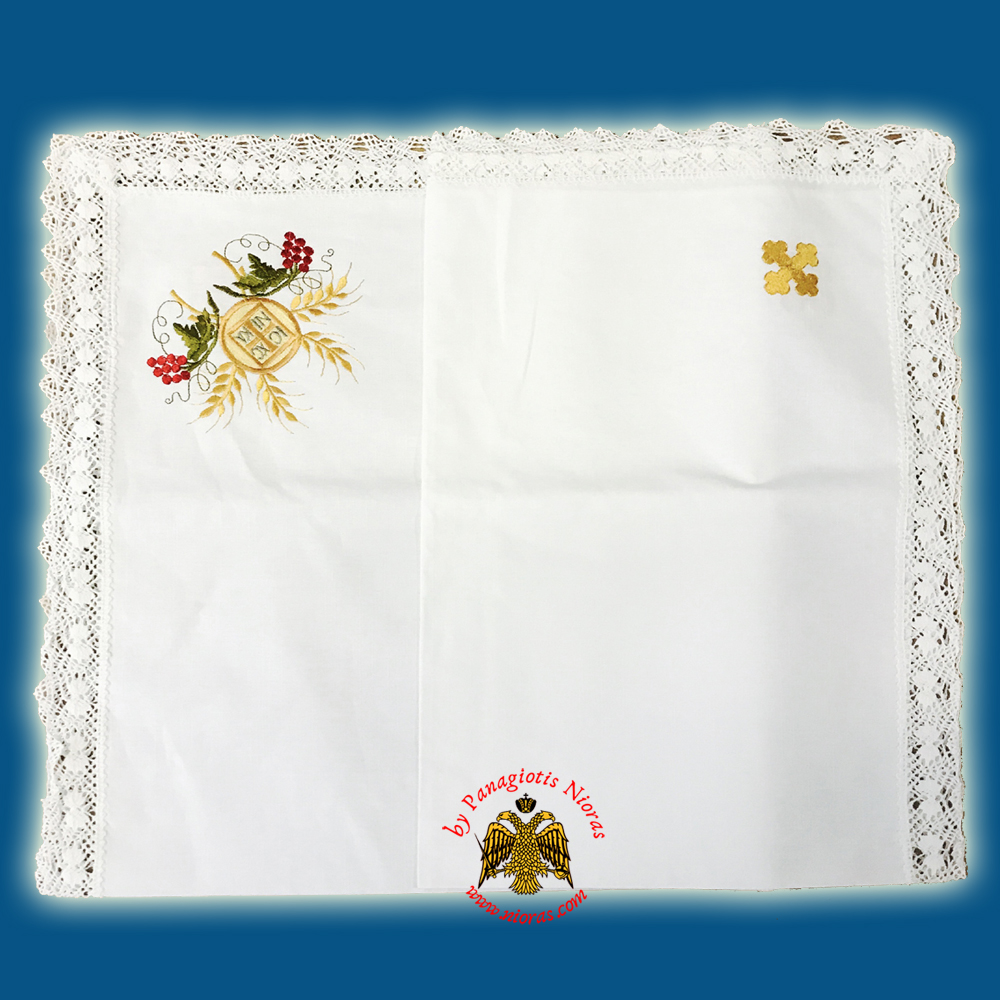
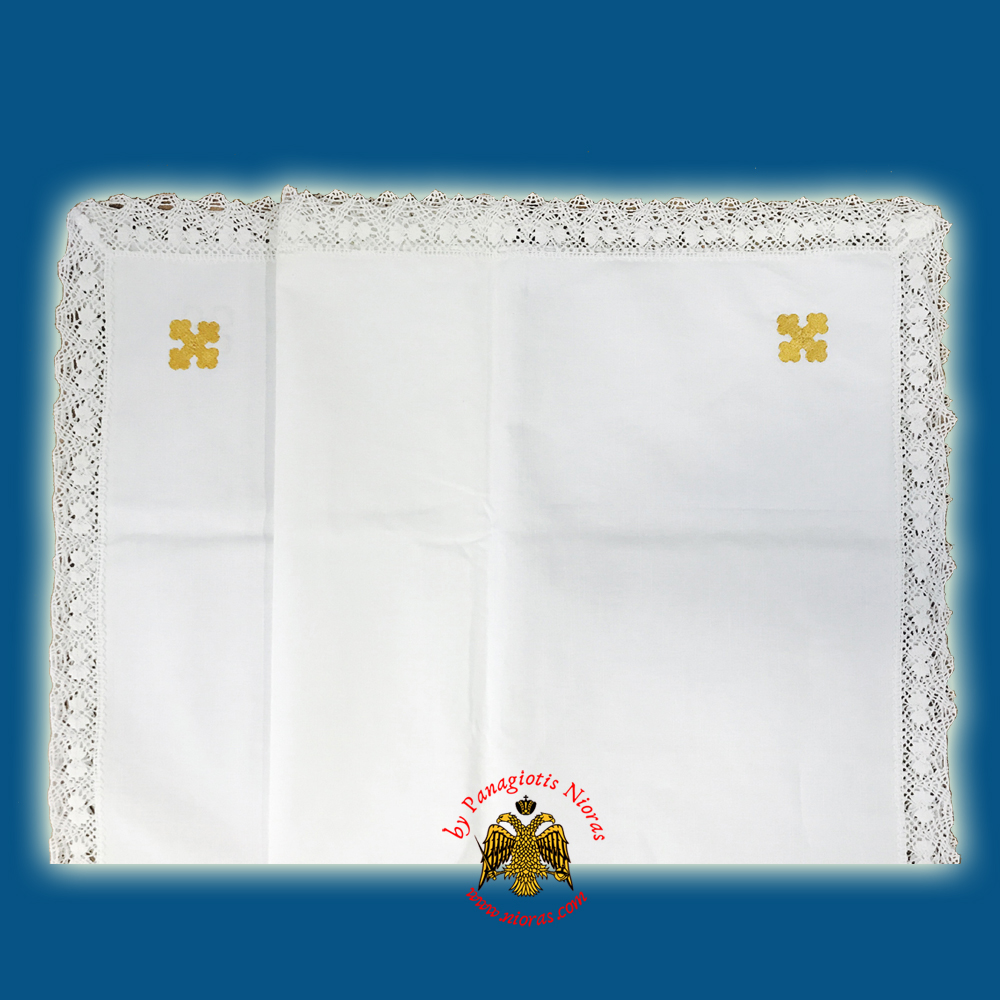


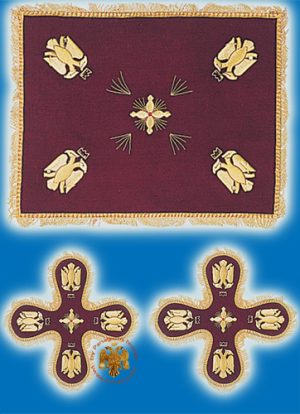
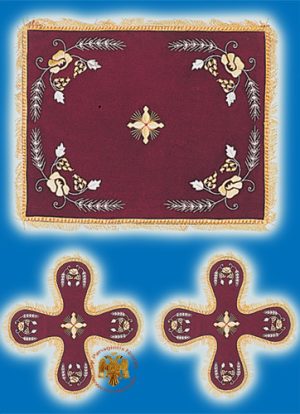
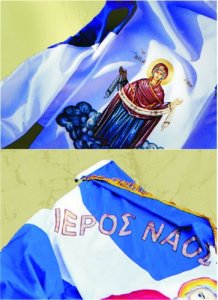
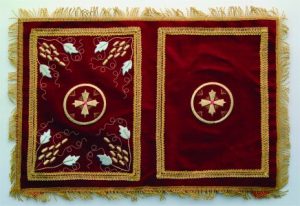

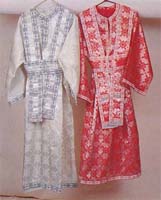



Reviews
There are no reviews yet.